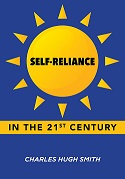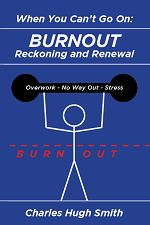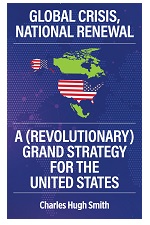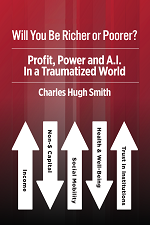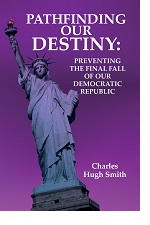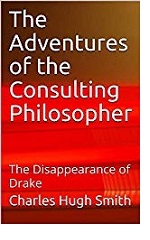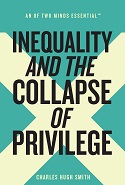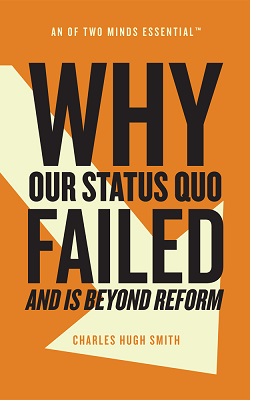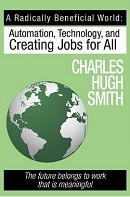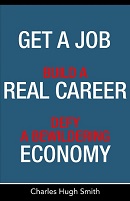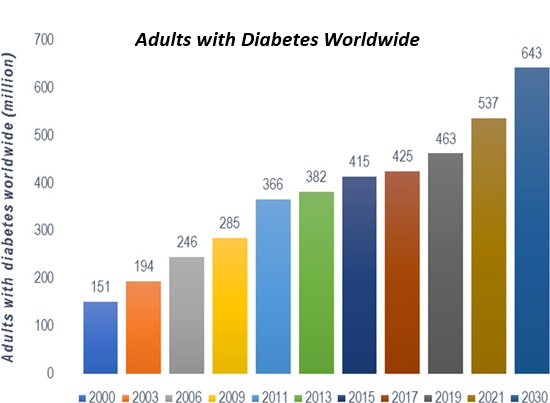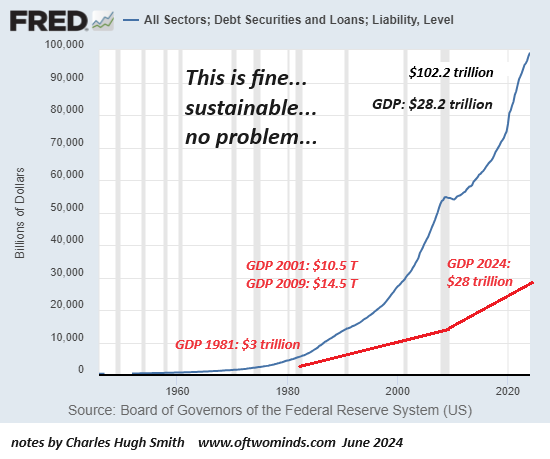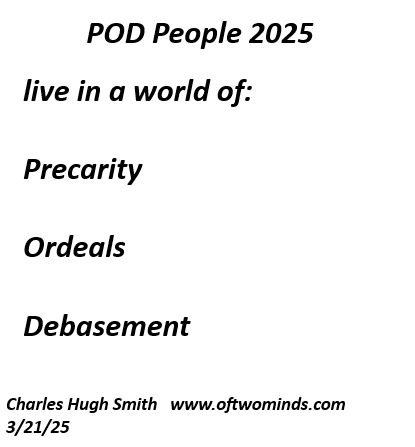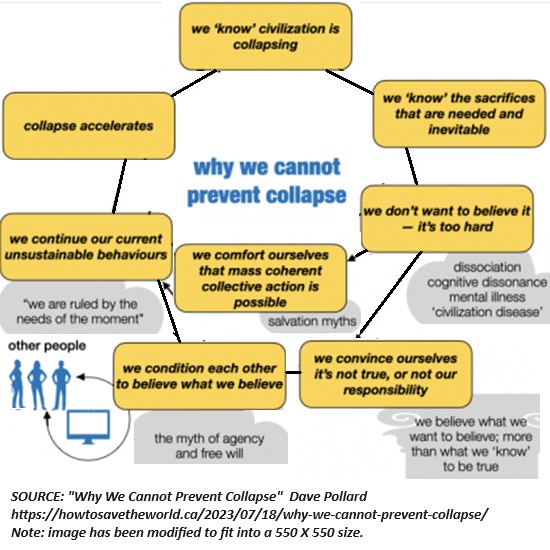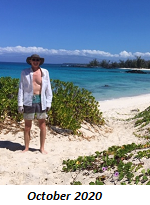The Global Trade Game: Jokers Are Wild
There may be no winners of the game of Global Domination (tm), and that is likely the best outcome.
Okay, players: jokers are wild, but with a twist: the entire deck is jokers. Since everyone at the table will have five Aces, nobody wins.
Welcome to the Trade War Poker Table: nobody wins, as everyone has the same hand of jokers.
This is not to say that exploitive, mercantilist "free trade" (no such thing has ever existed) is desirable, much less possible. We're reaping the consequences of what was passed off as "free trade": corporations gleefully gutted National Security to boost profits by offshoring everything that could be offshored.
Every nation can impose tariffs or limit imports by other means. Tit for tat tariffs, concessions, grand deals, side deals--everyone has access to the same deck of cards. Who wins each round of play is an open question, as is who wins the game.
There are several time-tested strategies in the game for Global Domination (tm). One is domination gained by exporting far more than you import, building up treasure in the form of vast trade surpluses.
The problem with this strategy is eventually the nations being stripped by your mercantilist strategy wise up and limit your exports. There is only one way to get around this: military force, i.e. establish a Colonial Empire in which your colonies are forced to buy your surplus production (exports) via a bayonet in their back.
Absent force and a colonial empire, mercantilism is eventually defeated by its own success.
There is another way to play for Global Domination (tm), and it's the exact opposite of mercantilism: run large, sustained trade deficits by importing more than you export, which beneath the surface is a remarkable flow of trade: the importing nation "exports" its currency in size in exchange for goods and services.
Once this currency is "exported" in sufficient quantities, it becomes the dominant currency simply from its ubiquity, its liquidity (i.e. its quantity and ubiquity make it easy to trade everywhere) and its trustworthiness due to its wide ownership across global markets: since the currency is spread across the globe, the issuing nation no longer controls its valuation; that's now set by the market.
This is Global Domination (tm) via financing trade rather than by running trade surpluses by exporting tangible goods. Pick one, as you can't have both: either export goods to run mercantilist trade surpluses, and build up a trove of other nation's currencies, or "export" your own currency via sustained trade deficits so it becomes the global lingua franca of financing trade.
Due to the demands of the Cold War, this was the U.S. strategy in the postwar era. As I have often explained, the U.S. was not merely in an arms race with the Soviet Union; it was also in a war for influence and alliances. The strongest adhesive in alliances is self-interest; by absorbing the surplus production of its allies in Europe and Asia in exchange for dollars, the U.S. cemented alliances that essentially encircled the Soviet Empire.
This strategy was far more effective than open conflict, but it came with a cost. Just as the success of mercantilism generates its own undoing, so too does maintaining a reserve currency via trade deficits / exporting one's currency. Should the issuing nation (in this era, the U.S.) decide to limit imports and reduce its trade deficit, its currency will slowly lose the global scale needed to sustain its market dominance.
This is Triffin's Paradox, which I've addressed many times over the years: any currency--and the system for creating and distributing the currency--has two masters it cannot possibly serve equally: the domestic economy and the global economy. Any nation that wants to control the valuation of its currency cannot possibly achieve global financial dominance, as the only way to gain and maintain global financial dominance is to surrender control of the currency's valuation to the market via exporting currency in such vast quantities that the global market sets the value.
There's a profound irony in this. To manage the domestic economy, the state wants to control everything: the issuance of currency and its valuation via its relative abundance or scarcity, which is reflected in the cost of credit (i.e. interest rates) and asset prices.
But to gain the high ground in the global financial landscape, the currency must serve the global demand for a currency that is ubiquitous, extremely liquid and trustworthy precisely because its value cannot be reset by state diktat. The valuation of a truly global currency is constantly influenced by interest rates, bond issuance, demand and so on--all the features of a transparent marketplace.

The game of Global Domination (tm) will never be decided by a deck of jokers. The real game is 5-card draw: you play the cards you've been dealt by Nature, history, culture and chance. Every nation has a spectrum of strengths and weaknesses, advantages and disadvantages. Some are rich in resources, some are poor in resources. Some have advantageous geography, some less so. Some have cultural coherence, others have diversity; each is a strength and a weakness.
In Nature, the winner is not necessarily the strongest or the one most blessed by chance. The winner tends to be the one with the greatest capacity and incentives for flexibility, experimentation, a level playing field (i.e. social mobility) decentralized capital and all the traits of fast adaptation: if not an appetite then at least a capacity for a continual churn of instability, failure and self-criticism, which are the necessary components of experimentation.
There may be no winners of the game of Global Domination (tm), and that is likely the best outcome. Any form of dominance generates its own undoing.
New podcast: The Coming Global Recession will be Longer and Deeper than Most Analysts Anticipate (42 min)
My recent books:
Disclosure: As an Amazon Associate I earn from qualifying purchases originated via links to Amazon products on this site.
The Mythology of Progress, Anti-Progress and a Mythology for the 21st Century print $18, (Kindle $8.95, Hardcover $24 (215 pages, 2024) Read the Introduction and first chapter for free (PDF)
Self-Reliance in the 21st Century print $18, (Kindle $8.95, audiobook $13.08 (96 pages, 2022) Read the first chapter for free (PDF)
The Asian Heroine Who Seduced Me (Novel) print $10.95, Kindle $6.95 Read an excerpt for free (PDF)
When You Can't Go On: Burnout, Reckoning and Renewal $18 print, $8.95 Kindle ebook; audiobook Read the first section for free (PDF)
Global Crisis, National Renewal: A (Revolutionary) Grand Strategy for the United States (Kindle $9.95, print $24, audiobook) Read Chapter One for free (PDF).
A Hacker's Teleology: Sharing the Wealth of Our Shrinking Planet (Kindle $8.95, print $20, audiobook $17.46) Read the first section for free (PDF).
Will You Be Richer or Poorer?: Profit, Power, and AI in a Traumatized World
(Kindle $5, print $10, audiobook) Read the first section for free (PDF).
The Adventures of the Consulting Philosopher: The Disappearance of Drake (Novel) $4.95 Kindle, $10.95 print); read the first chapters for free (PDF)
Money and Work Unchained $6.95 Kindle, $15 print) Read the first section for free
Become a $3/month patron of my work via patreon.com.
Subscribe to my Substack for free
NOTE: Contributions/subscriptions are acknowledged in the order received. Your name and email remain confidential and will not be given to any other individual, company or agency.
|
Thank you, DawgPond ($70), for your splendidly generous subscription to this site -- I am greatly honored by your support and readership. |
Thank you, Lucia U. ($70), for your marvelously generous subscription to this site -- I am greatly honored by your support and readership. |
|
|
Thank you, Peter C. ($70), for your magnificently generous subscription to this site -- I am greatly honored by your support and readership. |
Thank you, Gavin G. ($70), for your superbly generous contribution to this site -- I am greatly honored by your support and readership. |



